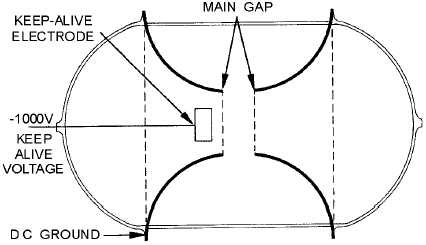2-22
should be extinguished as rapidly as possible. Extinguishing the arc stops any loss caused by the arc and
permits signals from nearby targets to reach the receiver.
The simple gap formed in air has a resistance during conduction of from 30 to 50 ohms. This is
usually too high for use with any but an open-wire transmission line. The time required for the air
surrounding the gap to completely deionize after the pulse voltage has been removed is about 10
microseconds. During this time the gap acts as an increasing resistance across the transmission line to
which it is connected. However, in a tr system using an air gap, the echo signals reaching the receiver
beyond the gap will be permitted to increase to half their proper magnitude 3 microseconds after the pulse
voltage has been removed. This interval is known as RECOVERY TIME.
Tr tubes are usually conventional spark gaps enclosed in partially evacuated, sealed glass envelopes,
as shown in figure 2-13. The arc is formed as electrons are conducted through the ionized gas or vapor.
You may lower the magnitude of voltage necessary to break down a gap by reducing the pressure of the
gas that surrounds the electrodes. Optimum pressure achieves the most efficient tr operation. You can
reduce the recovery time, or DEIONIZATION TIME, of the gap by introducing water vapor into the tr
tube. A tr tube containing water vapor at a pressure of 1 millimeter of mercury will recover in 0.5
microseconds. It is important for a tr tube to have a short recovery time to reduce the range at which
targets near the radar can be detected. If, for example, echo signals reflected from nearby objects return to
the radar before the tr tube has recovered, those signals will be unable to enter the receiver.
Figure 2-13.—Tr tube with keep-alive electrode.
Tr tubes used at microwave frequencies are built to fit into, and become a part of, a resonant cavity.
You may increase the speed with which the gap breaks down after the transmitter fires by placing a
voltage across the gap electrodes. This potential is known as KEEP-ALIVE VOLTAGE and ranges from
100 volts to 1,000 volts. A glow discharge is maintained between the electrodes. (The term GLOW
DISCHARGE refers to the discharge of electricity through a gas-filled electron tube. This is distinguished
by a cathode glow and voltage drop much higher than the gas-ionization voltage in the cathode vicinity.)
This action provides for rapid ionization when the transmitter pulse arrives.
Failure of the tr tube is primarily caused by two factors. The first and most common cause of failure
is the gradual buildup of metal particles that have been dislodged from the electrodes. Such metal bits
become spattered on the inside of the glass envelope. These particles act as small, conducting areas and
tend to lower the Q of the resonant cavity and dissipate power. If the tube continues in use for too long a



